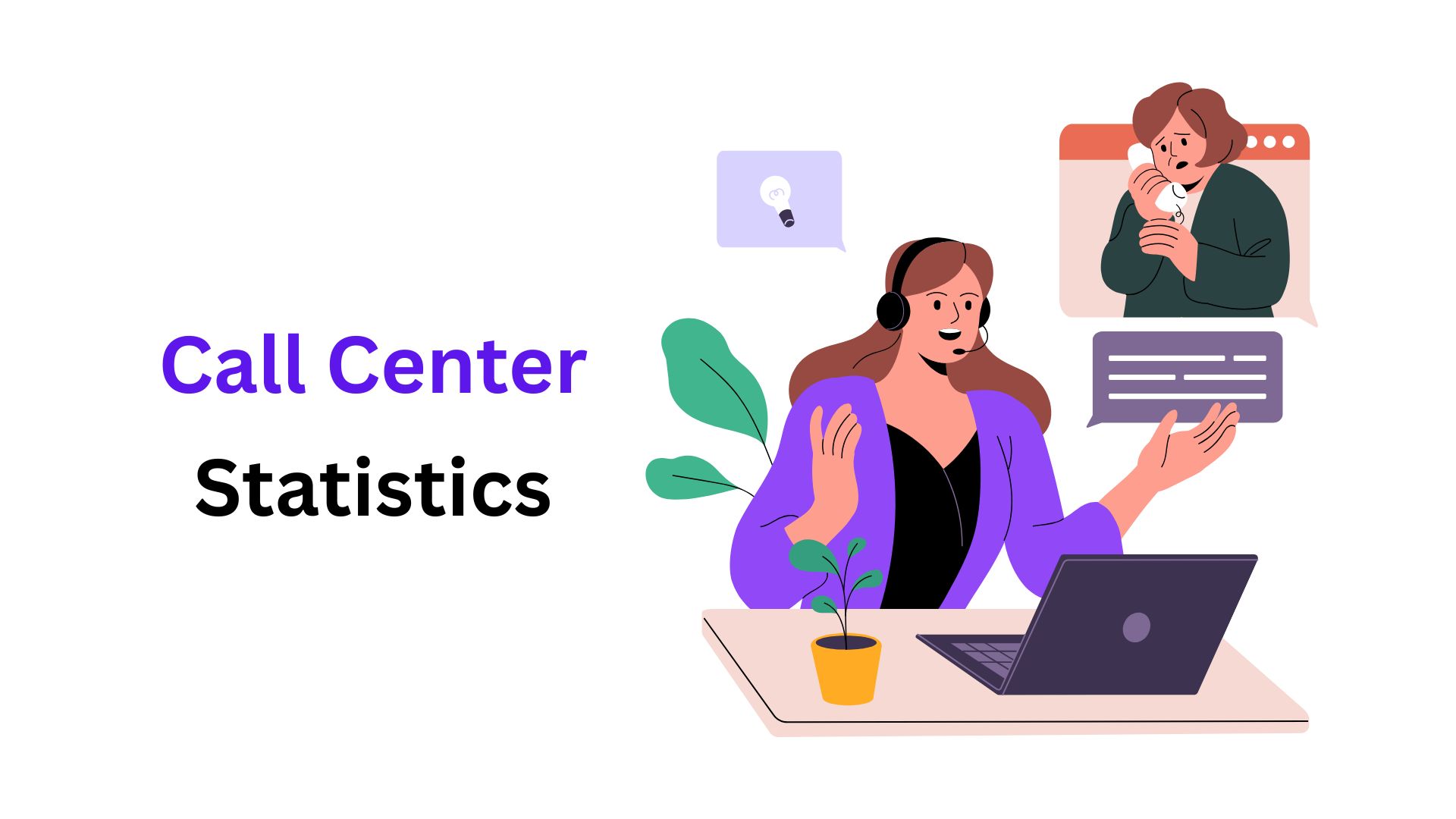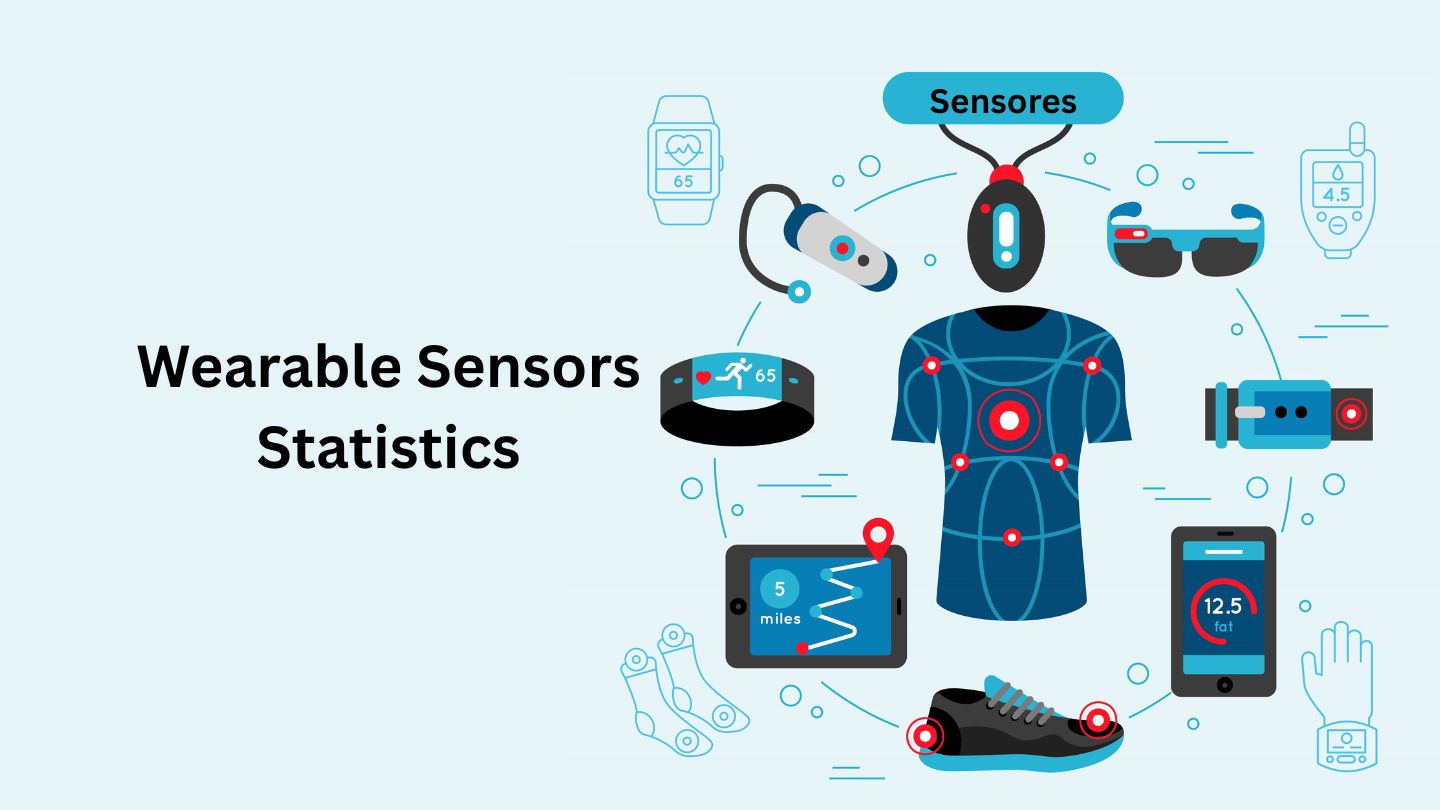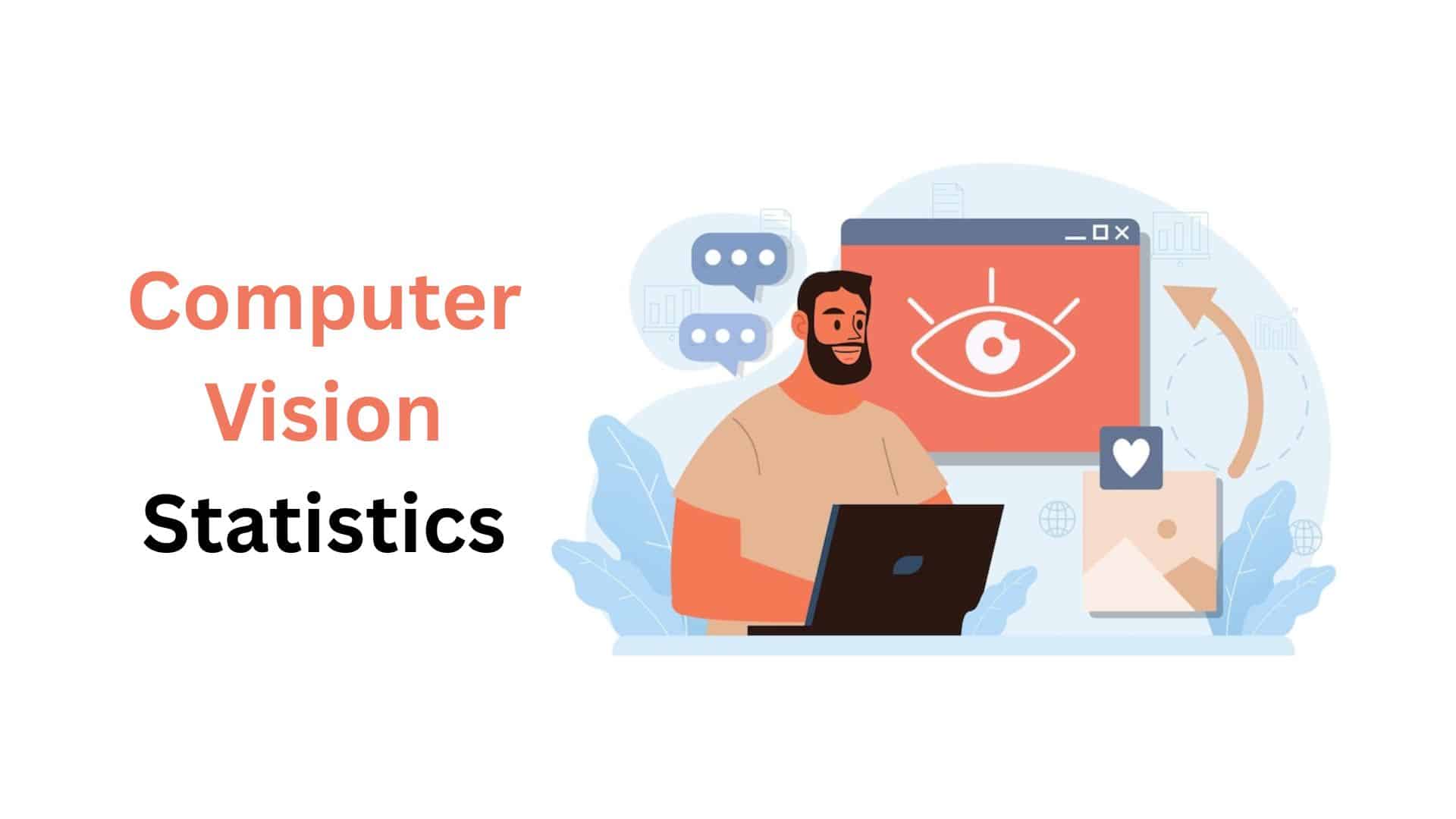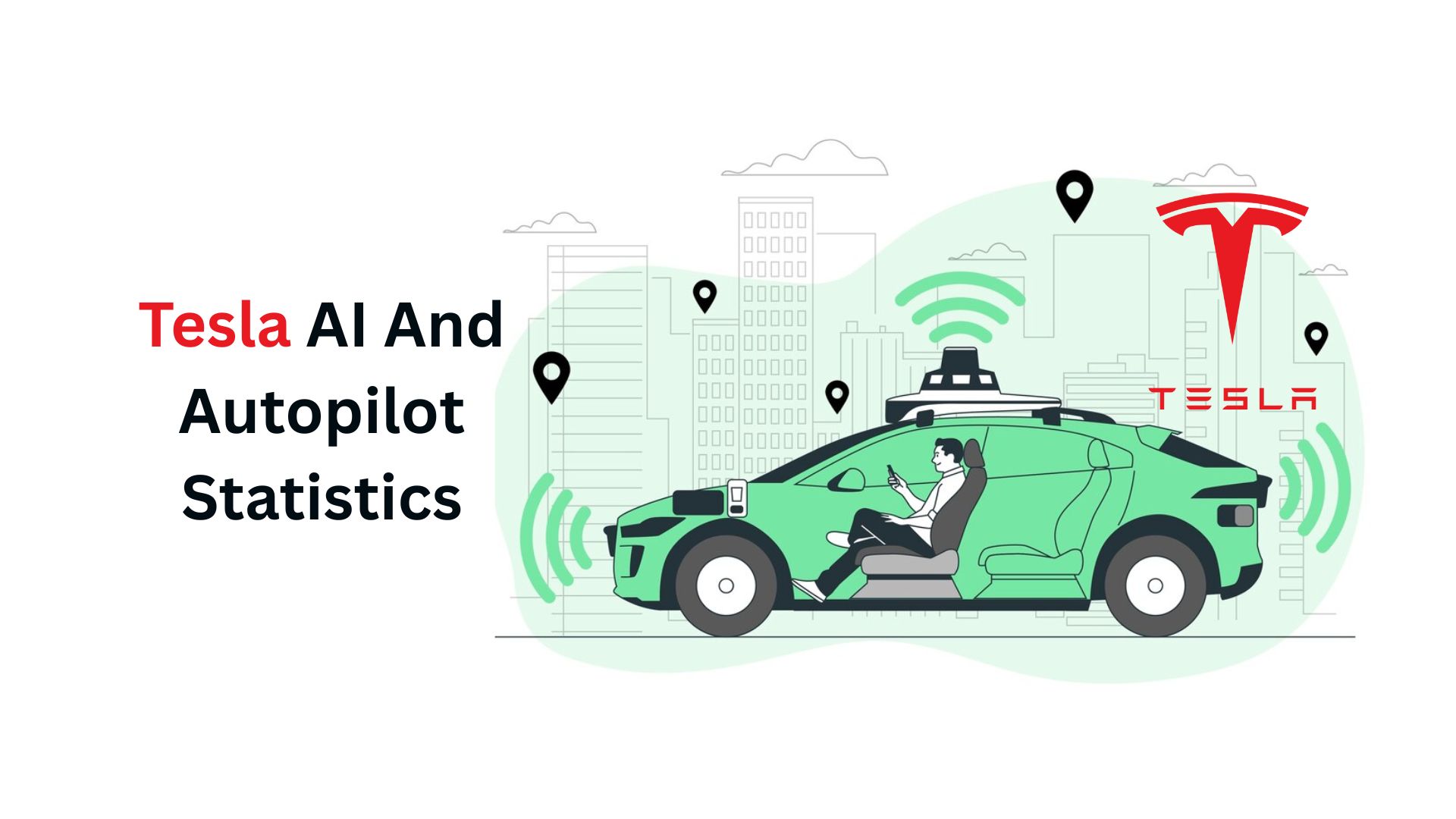Virtual Assistant Statistics By Productivity, Market Share, And Facts

Updated · Mar 03, 2025


TABLE OF CONTENTS
- Introduction
- Editor’s Choice
- General Virtual Assistant Statistics
- Medical Virtual Assistant Statistics
- Intelligent Virtual Assistant Statistics
- By Adoption in Home Statistics
- By Productivity
- By Market Share and Costs
- By Earnings and Salary
- By Education and Career
- Relationship Between AI and VA Statistics
- By Product Analyses
- Virtual Assistant Industry Statistics
- Top Virtual Assistant Tools Used in 2024
- Top 10 Businesses Using Virtual Assistants
- Benefits of Hiring Virtual Assistants
- Sustainable Initiatives of Virtual Assistants
- Conclusion
Introduction
Virtual Assistant Statistics: Virtual assistants (VAs) are now widely used in different industries because they can handle tasks quickly and efficiently. They help businesses with administrative work, customer support, data entry, scheduling, and even social media management.
In 2024, the demand for virtual assistants has increased greatly as companies look for affordable and flexible solutions. Many businesses prefer VAs because they help reduce costs and improve productivity.
The global market for virtual assistants (VAs) is expected to grow even more in the coming years. As more people understand their advantages, VAs will become an essential part of modern workplaces. Their ability to work remotely and handle multiple tasks makes them valuable assets for businesses of all sizes.
Editor’s Choice
- The worldwide market for virtual assistants is estimated to reach USD 20.21 billion by 2024, an increase from USD 16.08 billion in 2023.
- Virtual Assistant Statistics in 2024 show that more than 40% of small businesses in the U.S. are using virtual assistants, making them more popular than ever.
- In the same duration, more than 53% of businesses plan to use AI-powered virtual assistants more for customer service.
- Common tasks for virtual assistants include scheduling, entering data, managing social media, and handling customer support.
- More than 60% of virtual assistants find work as freelancers on sites like Upwork and Fiverr.
- In contrast, about 70% of startups use virtual assistants to grow their business without big costs.
- AI virtual assistants are becoming more chatty, with 73% of users saying interactions feel better.
- Virtual Assistant Statistics further reports that in 2024, virtual assistants will mainly be used in the healthcare, real estate, and e-commerce industries.
- Hiring a virtual assistant can save businesses 30% to 50% compared to hiring full-time staff.
- The virtual assistant industry is predicted to add over 1.2 million jobs worldwide by 2025.
You May Also Like To Read
- Smart Home Statistics
- Sleep Tracker Statistics
- Smart Speaker Statistics
- Apple Watch Statistics
- Smart Alarm Systems Statistics
General Virtual Assistant Statistics
- Employers in the U.S. could save over USD 11,000 annually by hiring full-time virtual assistants.
- As of 2024, hiring virtual assistants can cut a company’s operating costs by up to 78%.
- There are roughly 12 million freelancers on Upwork, about 20 million on Freelancer, and around 3 million on Fiverr.
- Wikipedia estimates that around 25,000 people are working as Virtual Assistants worldwide.
- Virtual assistants are 78% more cost-effective than full-time, on-site employees.
- VAs saved 78% of costs compared to hiring full-time employees to work on-site.
- By 2027, the global virtual assistant market is expected to grow to USD 44.25 billion, with an annual growth rate of 20.3%.
- In 2024, the demand for virtual assistants rose by 35%, mainly because more companies shifted to remote work and needed flexible staffing solutions.
- Today, there are around 40 million virtual assistants worldwide. Many of them come from regions like Latin America, Asia, and Eastern Europe, where remote work opportunities are increasing.
Medical Virtual Assistant Statistics
- The global medical virtual assistant market size is projected to grow from USD 0.6 billion in 2024 to an estimated USD 0.8 billion by 2025.
- The market will reach USD 5.9 billion by the end of 2033, with a compound annual growth rate (CAGR) of 28.1% from 2024 to 2033.
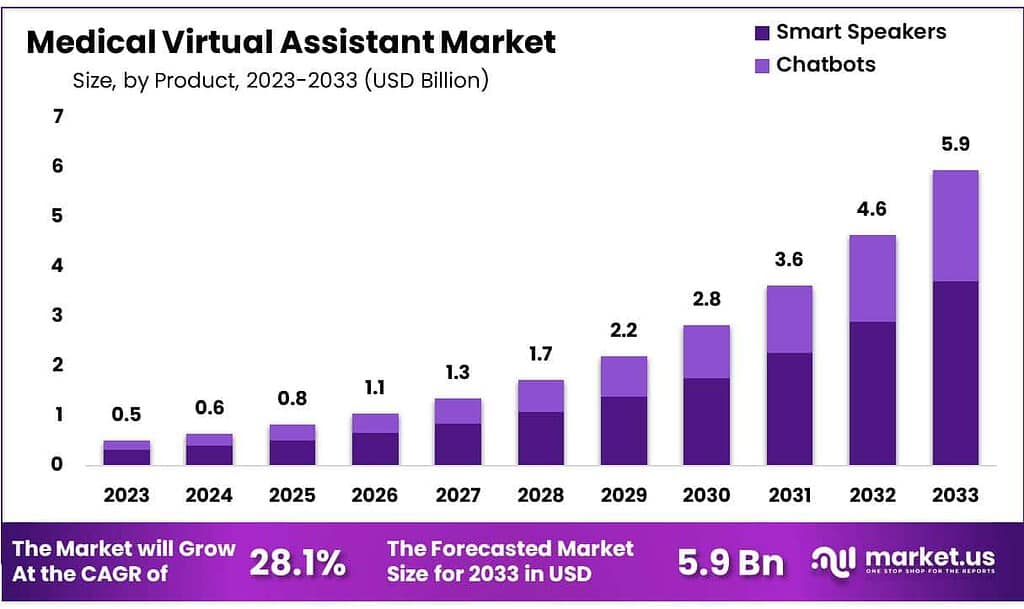
- Approximately 29% of healthcare leaders invested in generative AI technologies in 2024.
- By 2024, 44% of healthcare organizations will have implemented voice technology, and an additional 39% planned to adopt it within two years.
- AI-powered virtual assistants have been shown to reduce clinical documentation time by up to 50%
- Despite growth, 1% of AI-generated medical transcripts in 2024 contained inaccuracies.
- In 2023, smart speakers led the product segment with a 62.4% market share.
- Automatic speech recognition held a significant share of 53.7% within the user interface categories.
- Healthcare providers were the primary end-users, commanding a 48.9% revenue share in the market.
- North America was the leading region, with a 39.2% market share in 2023.
Intelligent Virtual Assistant Statistics
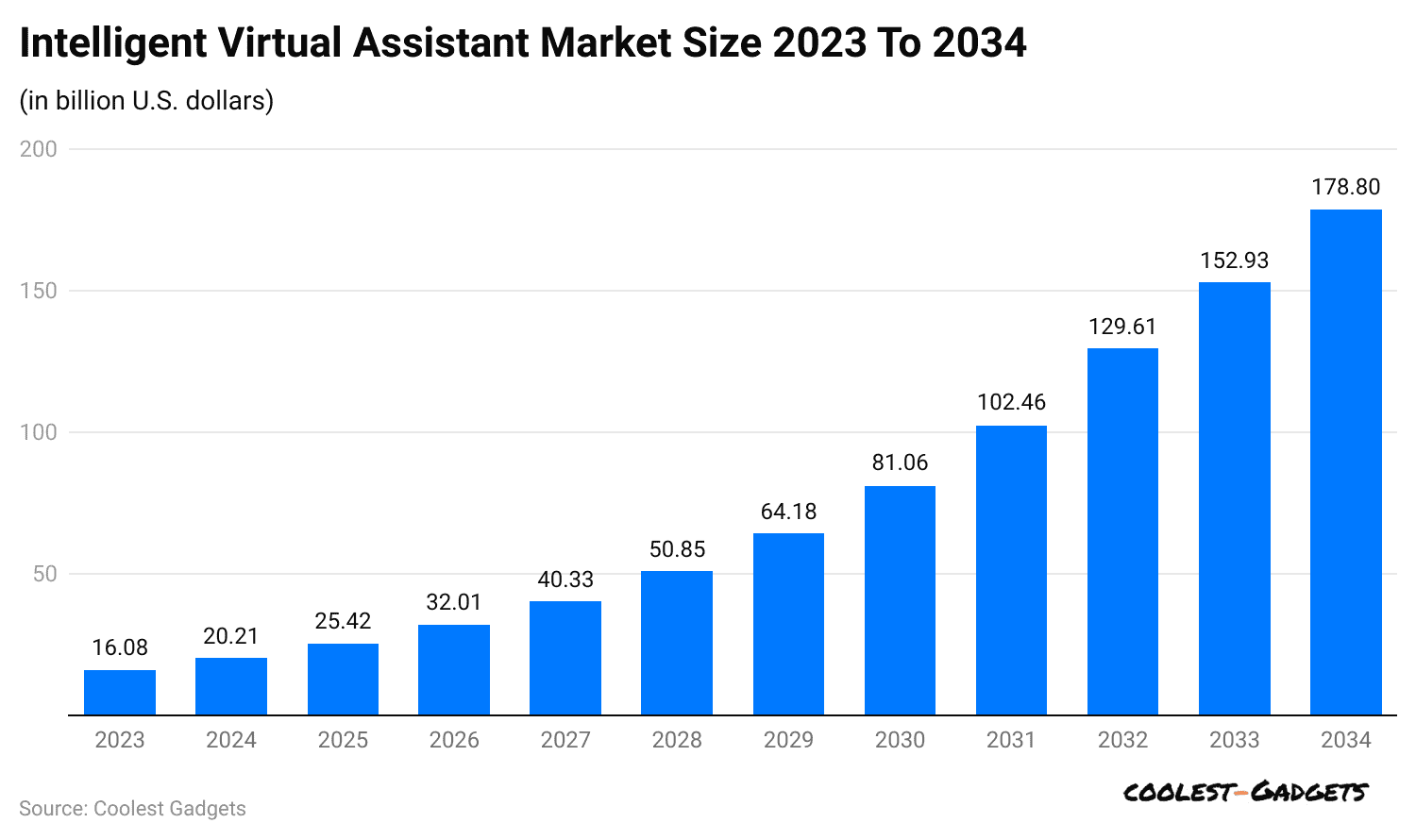 (Reference: Precedence Research)
(Reference: Precedence Research)
- The global market for virtual assistants will grow around USD 25.42 billion by 2025, increased from USD 20.21 billion in 2024.
- The market’s annual growth will be 24% of CAGR from 2024 to 2034, resulting in USD 178.80 billion by the end of 2034.
- Furthermore, the estimated market size in coming years is 2025 (USD 25.42 billion), 2026 (USD 32.01 billion), 2027 (USD 40.33 billion), 2028 (USD 50.85 billion), 2029 (USD 64.18 billion), 2030 (USD 81.06 billion), 2031 (USD 102.46 billion), 2032 (USD 129.61 billion), and 2033 (USD 152.93 billion).
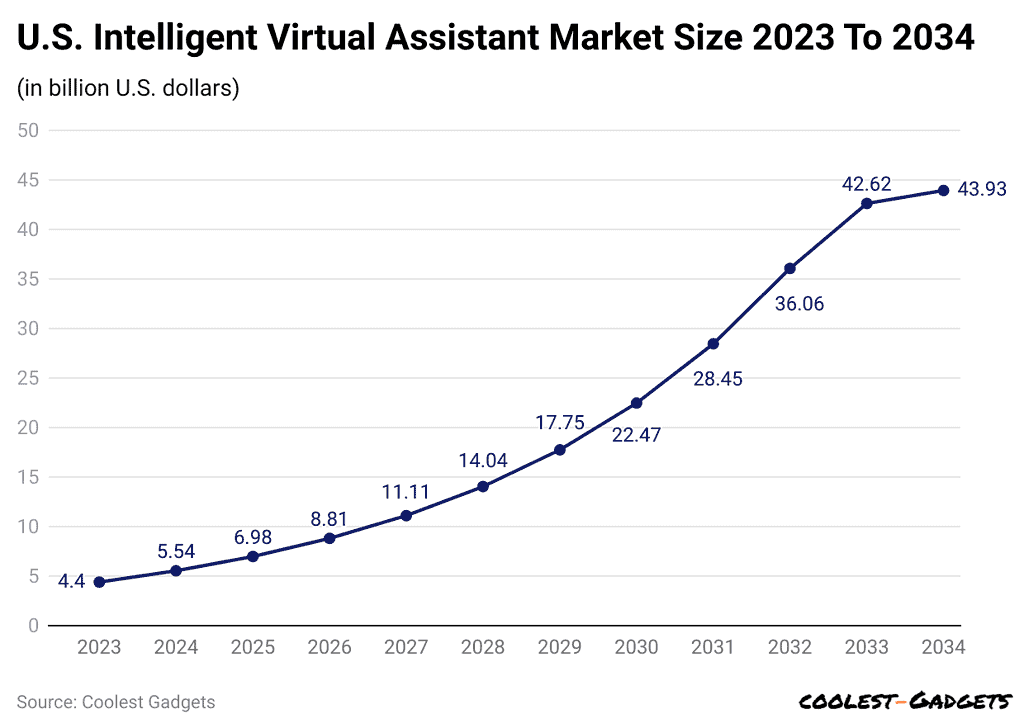 (Reference: Precedence Research)
(Reference: Precedence Research)
- Virtual Assistant Statistics also depicts that the United States market for smart virtual assistants is valued up to USD 6.98 billion by 2025 and is expected to grow to USD 5.54 billion by 2024.
- The market will reach approximately USD 49.93 billion by 2034, growing at a 24.59% CAGR from 2024 to 2034.
- Similarly, the expected market size in the next few years will be 2025 (USD 6.98 billion), 2026 (USD 8.81 billion), 2027 (USD 11.11 billion), 2028 (USD 14.04 billion), 2029 (USD 17.75 billion), 2030 (USD 22.47 billion), 2031 (USD 28.45 billion), 2032 (USD 36.06 billion), and 2033 (USD 42.62 billion).
By Adoption in Home Statistics
- By 2024, about 60% of homes around the world will use at least one virtual assistant.
- The top virtual assistants used worldwide are Amazon Alexa (40%), Google Assistant (38%), and Apple Siri (22%).
- Meanwhile, around 60% of smart speaker owners use them daily for reminders, music, or controlling devices.
- In the last two years, the use of virtual assistants in smart homes has grown by 35%.
- Virtual Assistant Statistics in 2024 reports that people are expected to buy more than USD 40 billion worth of products using voice commands.
- Virtual assistants are now available in more than 100 languages.
- Almost 45% of seniors over 60 use virtual assistants for tasks like reminders or entertainment.
- More than 30% of cars worldwide now have voice assistants for navigation, music, and calls.
- Almost half of users worry about their privacy and data security when using virtual assistants.
- About 22% of virtual assistant users track fitness and health data, up 15% from 2023.
By Productivity
- Virtual assistants can boost workforce productivity by as much as 35%.
- As of 2024, 92% of Virtual Assistants are very satisfied with the flexibility of their work schedules.
- 85% of virtual workers said they feel more productive when working from home.
- Virtual Assistant Statistics further depict that only 13% of workers get more work done when they work from home.
- Industry data shows that virtual assistants usually work about 20 hours a week with flexible hours.
- On average, businesses save 22 minutes daily by using virtual assistants to handle tasks.
- Entrepreneurs save about 13 to 15 hours every week when they assign tasks to virtual assistants.
- Most virtual assistants (87.6%) are women, while 12.4% are men.
- There is also a pay gap in this field, with women earning 93 cents for every dollar men make.
- Most virtual assistants are over 40 years old, making up 78% of the total population.
- White individuals make up 66.5% of all virtual assistants, the largest ethnic group in this field.
- Meanwhile, around 16% of virtual assistants are Hispanic or Latino, and 9.1% are Black or Afro-American.
- As mentioned in Virtual Assistant Statistics, virtual assistants of Asian ethnicity earn the highest average salary, while White assistants earn USD 43,074 yearly.
- Most virtual assistants, about 69.3%, are married.
By Earnings and Salary
- Virtual Assistant Statistics elaborates that in the United States, a Virtual Assistant earns an average yearly salary of about USD 39,915.
- An Entry-Level Virtual Assistant earns about USD 29,000 yearly, or roughly USD 19.19 per hour in 2024.
- In the U.S., virtual assistants usually charge between USD 13 and USD 25 per hour for their services.
- Meanwhile, virtual assistants earn the most in Hawaii (USD 53,760), Washington (USD 53,236), and Alaska (USD 52,452).
- Most virtual assistants, about 87.7%, are paid based on the number of hours they work.
- Approximately 68% of freelance virtual assistants often work with different clients, juggling multiple tasks or projects.
By Education and Career
- Three key soft skills for virtual assistants are communication, time management, and writing abilities.
- In 2024, most virtual assistants have a bachelor's degree (54%), followed by an associate degree (22%) and a high school diploma (9%).
- Data entry is the most common skill on virtual assistant resumes, found in 9.3% of them, followed by customer service at 7.8% and email management (7.6%).
- A typical virtual assistant resume has about 412 words and is roughly 0.9 pages long.
- Virtual Assistant Statistics also show that about 59% of virtual assistants work full-time.
- Almost 45% of virtual assistants have a bachelor’s degree.
- A major challenge for 41% of users is finding a reliable and trustworthy VA to hire.
Relationship Between AI and VA Statistics
- The AI Virtual Assistant market is expected to reach USD 21.7 billion by 2024, growing 34.7% annually from 2020 to 2024.
- Meanwhile, over 4.2 billion people worldwide use voice assistants like Siri, Alexa, and Google Assistant.
- By 2025, more than 60% of businesses aim to use AI Virtual Assistants for customer support.
- According to reports of Virtual Assistant Statistics, 75% of users say AI assistants make tasks faster and improve service.
- AI assistants in the healthcare sector are predicted to help with admin, patient communication, and data, reaching USD 1.5 billion.
- AI assistants in e-commerce manage about 30% of customer questions.
- Nearly half of consumers trust AI assistants for tasks like shopping advice and customer service.
By Product Analyses
AI-powered virtual Assistants (Voice Assistants)
- By 2024, about 55% of people worldwide will use AI voice assistants, and over 8 billion devices are expected by 2025.
- The AI voice assistant market is predicted to grow 30% annually, reaching USD 26 billion by 2030.
Chatbots for Customer Service
- In 2024, about 67% of companies are expected to use AI chatbots, spending USD 3 billion yearly.
- Businesses that use chatbots for customer service experience faster responses and lower costs by 25%.
- The chatbot market is predicted to grow 35% annually from 2024 to 2030, reaching USD 15 billion.
Virtual Executive Assistants (VEAs)
- Virtual Assistant Statistics In 2024, it was estimated that around 27% of medium-sized businesses and 35% of large companies were using virtual executive assistants (VEAs) to help with administrative work.
- Companies that use VEAs say they see an average increase in productivity of 40%.
- The market for virtual executive assistants is expected to grow by 20% each year and reach a value of USD 6.2 billion by 2030.
Personalized Virtual Assistants
- In the same duration, almost 43% of people using AI-powered virtual assistants are doing shopping, getting entertainment suggestions, and tracking their health.
- The overall market for AI-powered services will reach USD 45 billion by 2028, with a growth rate of 29% per year.
Industry-Specific Virtual Assistants
- Only 12% of healthcare workers are using virtual assistants to help with tasks like managing patients and scheduling appointments in 2024, and this will reach USD 2.5 billion by 2028.
- In the financial sector, around 15% of banks and financial institutions are using virtual assistants to handle transactions and assist customers, and is predicted to reach USD 5 billion by 2030.
You May Also Like To Read
- Smart Rings Statistics
- Smart Dishwasher Statistics
- Fitness Rings Statistics
- Smart Home Devices Statistics
- Fitness Trackers Statistics
Virtual Assistant Industry Statistics
- More than 53% of businesses plan to use AI-powered virtual assistants more for customer service.
- In 2024, virtual assistants will mostly be used in healthcare, real estate, and online shopping.
- Half of the top 10 real estate teams use virtual assistants from MyOutDesk for support.
- About 30.9% of virtual assistants have business degrees, allowing them to work in many fields.
- Around 24% of small businesses hire outside help to improve their operational efficiency.
Top Virtual Assistant Tools Used in 2024
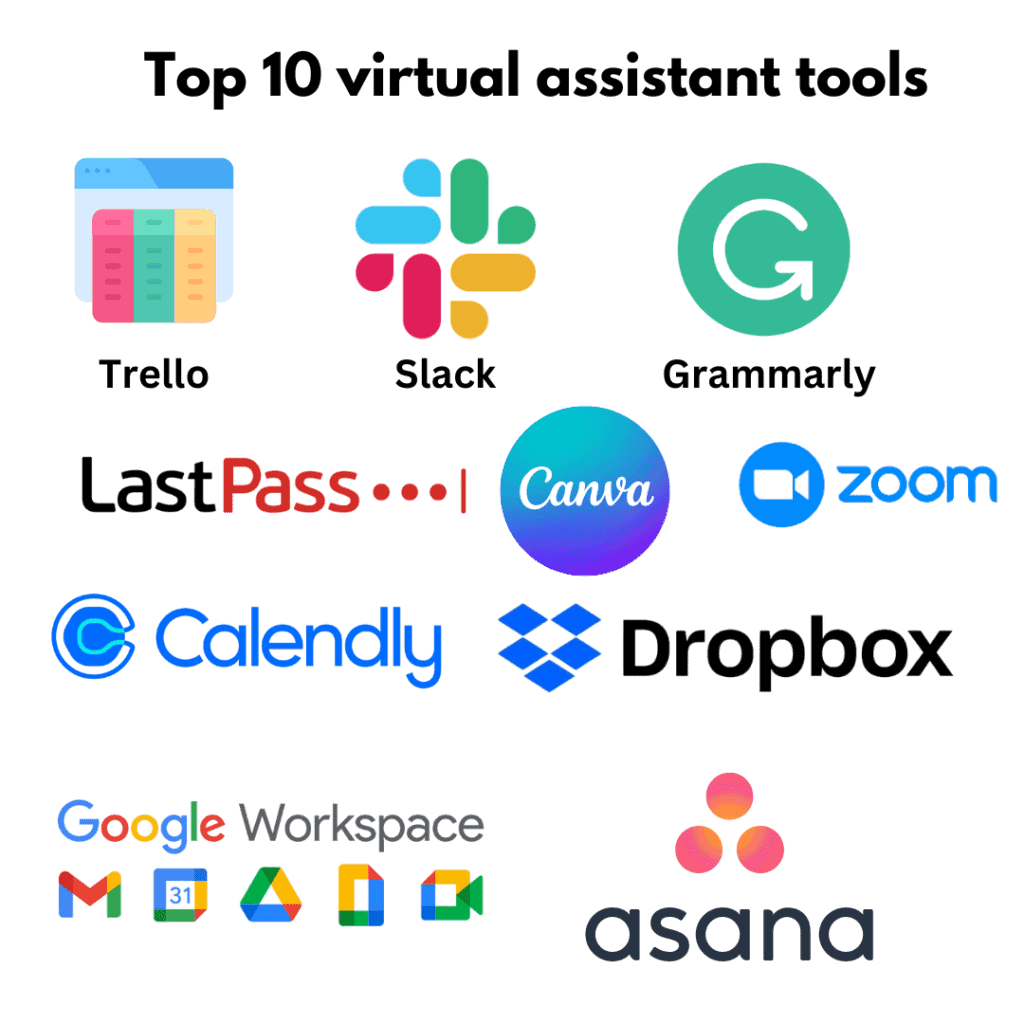
(Source: helpsquad.com)
| Name | Primary Function | Statistics |
|
Asana |
Project Management | Utilized by over 1.3 million paid users worldwide. |
| Slack | Communication Platform |
Employed by 65 of the Fortune 100 companies. |
|
Grammarly |
Writing Enhancement | Serves over 30 million daily users. |
| Trello | Task Management |
Supports more than 50 million registered users. |
|
Zoom |
Video Conferencing | Hosts over 300 million daily meeting participants. |
| Dropbox | File Sharing |
Has over 700 million registered users. |
|
LastPass |
Password Management | Protects passwords for over 25.6 million users. |
| Hootsuite | Social Media Management |
Manages social media for over 18 million users. |
|
QuickBooks |
Accounting Software | Used by over 7 million small businesses. |
| Canva | Graphic Design |
Boasts over 60 million monthly active users. |
Top 10 Businesses Using Virtual Assistants
| Businesses | Statistics |
| Amazon |
Alexa is used in more than 100 million devices around the world. |
|
|
Google Assistant is used on more than 1 billion devices. |
| Apple |
More than 500 million people around the world use Siri. |
|
Microsoft |
In 2023, more than 200 million people used Cortana every month. |
| Bank of America |
Erica has helped more than 30 million customers since it was launched. |
|
HSBC |
HSBC's AI virtual assistant has handled millions of customer questions. |
| Lufthansa |
Mildred manages more than 2 million requests each year. |
|
Vodafone |
TOBi manages over 12 million interactions every month. |
| Sephora |
The assistant has helped more than 3 million people. |
|
KLM |
BlueBot has successfully managed more than 30 million customer questions. |
Benefits of Hiring Virtual Assistants
- As of 2024, hiring full-time virtual assistants can help U.S. employers cut operating costs by up to 78% each year.
- A survey found that 77% of remote workers feel more productive compared to working in an office.
- More than half of the tasks assigned to virtual assistants were once handled by in-house employees.
- On average, virtual assistants take fewer sick days than regular office employees.
- When employees work remotely, their productivity improves by at least 13%.
Sustainable Initiatives of Virtual Assistants
- In 2024, virtual assistants in healthcare helped cut down paper use by around 18%.
- More than 15% of financial institutions have started using virtual assistants to automate tasks such as processing transactions, answering account questions, and detecting fraud.
- By this year's end, companies that use virtual assistants reduced their CO2 emissions by around 3 million metric tons every year.
- The market for eco-friendly virtual assistants is expected to grow by 25% each year until 2028.
- About 10% of large companies are using virtual assistants to improve resource management, helping to cut waste by as much as 15%.
Conclusion
A virtual assistant is a helpful tool that promotes the possibility of making life easier by handling tasks like scheduling, answering emails, or managing reminders. They also help save time and enhance productivity, allowing users to focus on more important things. Due to advancements in technology, virtual assistants are becoming smarter and more efficient.
Whether for personal use or business, they are valuable resources that can help you stay organized and accomplish your goals more easily. In recent years, investing in a virtual assistant can lead to better time management and success.
Sources
FAQ.
This software helps with tasks like scheduling, reminders, and answering questions through voice or text.
No, virtual assistants aren’t just for businesses. They can help individuals with tasks like scheduling, reminders, and organisation.
Virtual assistants can be expensive, but the cost depends on their skills, experience, and the tasks you need them to perform.
Yes, a virtual assistant can be used on the phone, helping with tasks like calling, texting, and searching.
To choose the right Virtual Assistant, look for skills, experience, communication, and reliability to fit your specific needs.

Saisuman is a talented content writer with a keen interest in mobile tech, new gadgets, law, and science. She writes articles for websites and newsletters, conducting thorough research for medical professionals. Fluent in five languages, her love for reading and languages led her to a writing career. With a Master’s in Business Administration focusing on Human Resources, Saisuman has worked in HR and with a French international company. In her free time, she enjoys traveling and singing classical songs. At Coolest Gadgets, Saisuman reviews gadgets and analyzes their statistics, making complex information easy for readers to understand.



